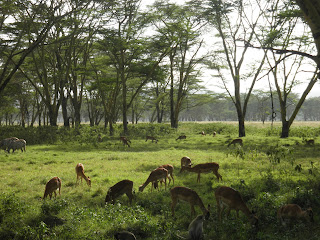On my last night in Nairobi I went with friends to see a local movie 'Nairobi Half Life' which was excellent. The movie itself, as well as the venue, seemed to me to hold all the contrasts that characterise Kenya today - elegance, poverty, violence, solidarity.
On our last morning at Lake Nakuru National Park we were alerted to a predator by the impala; scanning the vicinity I spotted a leopard jumping over a fallen tree. Later it wondered across the road in front of us in search of an impala kid. In all we saw about 18 different species of mammal and countless birds. The lake is very full as my photos below show; not many of the flamingo for which the park is famous were present. My colleagues and I, though not experts, could not help but feel that the biology of the park was out of kilter. We surmised that the absence of elephant was having negative effects on thorny acacia recruitment and, instead, favouring excess weedy species invasion as undergrowth. This may have been exacerbated by a very heavy stocking rate of Cape Buffalo.
The park is also touted in most of the promotional literature as the site of some of the main Euphorbia forests in Kenya. What these same web-sites do not mention is that almost none of this unique forest remains. I am still to find an explanation for the forest's disappearance. Perhaps over grazing by black rhino, one of my Sth African colleagues suggested?
The research that took me to Kenya concerned how social and biophysical scientists were working together to address issues of food security and poverty alleviation. Historically these two groups of researchers have not always worked well together. I now know much more about African Swine Fever - one of the projects of concern. I left impressed with the efforts being made.










No comments:
Post a Comment